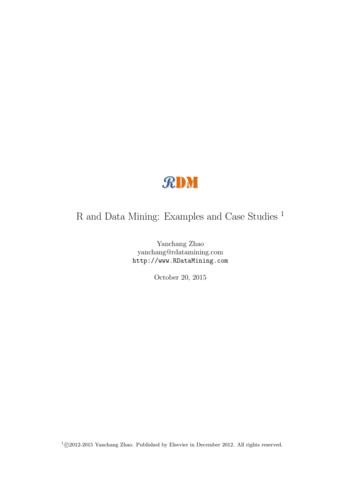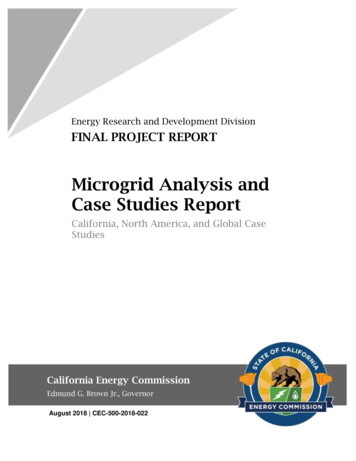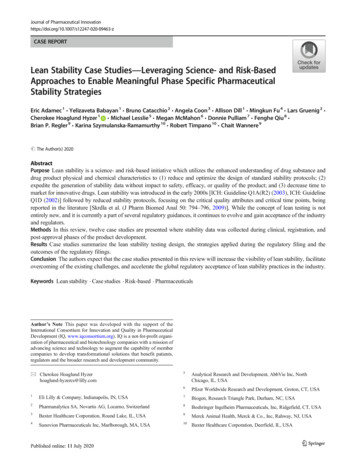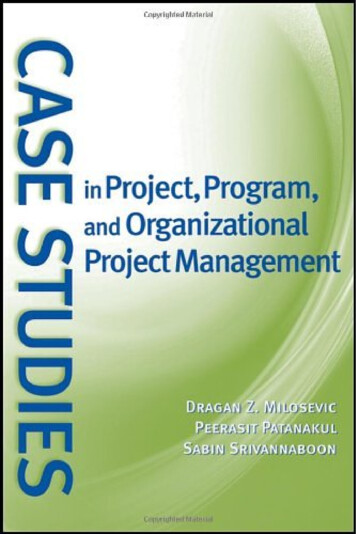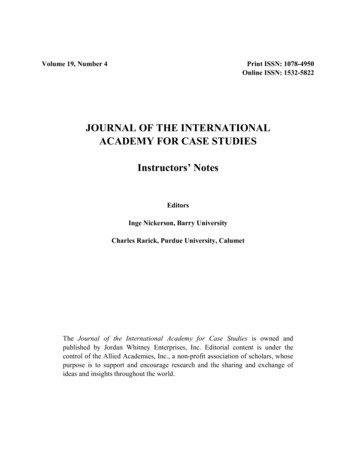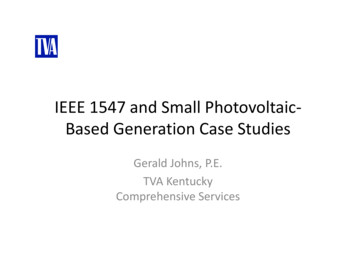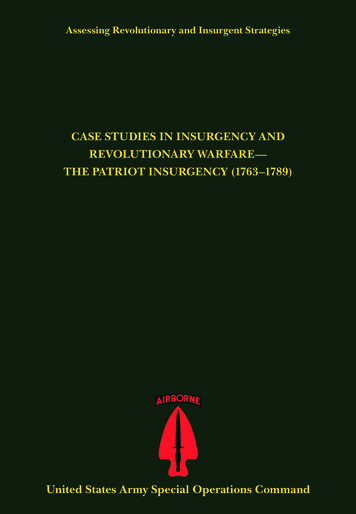
Transcription
Assessing Revolutionary and Insurgent StrategiesCASE STUDIES IN INSURGENCY ANDREVOLUTIONARY WARFARE—THE PATRIOT INSURGENCY (1763–1789)United States Army Special Operations Command
Assessing Revolutionary and Insurgent StrategiesCASE STUDIES IN INSURGENCY ANDREVOLUTIONARY WARFARE—THE PATRIOT INSURGENCY(1763–1789)Robert R. Leonhard, Lead AuthorJohns Hopkins University Applied Physics Laboratory (JHU/APL)JHU/APL Contributing AuthorsSummer D. AganStephen P. PhillipsUnited States Army Special Operations Command
Case Studies in Insurgency and Revolutionary Warfare—The Patriot Insurgency (1763-1789) is a work of the United States Government in accordance with Title 17, United States Code, sections 101 and 105.Published by the United States Army Special Operations CommandFort Bragg, North CarolinaCopyright 2019 by the United States Army Special OperationsCommand.First EditionISBN (print): ####ISBN (e-book): ####doi/CIP data?Printed in the United States of America by the GovernmentPrinting OfficeCite me as:Leonhard, Robert, et al. Case Studies in Insurgency and Revolutionary Warfare: The Patriot Insurgency (1763-1789). Fort Bragg: US ArmySpecial Operations Command, 2019.
Reproduction in whole or in part is permitted for any purpose ofthe United States government. Nonmateriel research on special warfare is performed in support of the requirements stated by the UnitedStates Army Special Operations Command, Department of the Army.This research is accomplished at the Johns Hopkins University AppliedPhysics Laboratory by the National Security Analysis Department, anongovernmental agency operating under the supervision of the USASOC Sensitive Activities Division, Department of the Army.The analysis and the opinions expressed within this documentare solely those of the authors and do not necessarily reflect the positions of the US Army or the Johns Hopkins University Applied PhysicsLaboratory.Comments correcting errors of fact and opinion, filling or indicating gaps of information, and suggesting other changes that may beappropriate should be addressed to:United States Army Special Operations CommandG-3X, Sensitive Activities Division2929 Desert Storm DriveFort Bragg, NC 28310All ARIS products are available from USASOC at www.soc.milunder the ARIS link.
ASSESSING REVOLUTIONARY ANDINSURGENT STRATEGIESThe Assessing Revolutionary and Insurgent Strategies (ARIS) series consists of a set of case studies and research conducted for the US Army SpecialOperations Command by the National Security Analysis Department of theJohns Hopkins University Applied Physics Laboratory.The purpose of the ARIS series is to produce a collection of academicallyrigorous yet operationally relevant research materials to develop and illustrate a common understanding of insurgency and revolution. This research,intended to form a bedrock body of knowledge for members of the SpecialForces, will allow users to distill vast amounts of material from a wide arrayof campaigns and extract relevant lessons, thereby enabling the developmentof future doctrine, professional education, and training.From its inception, ARIS has been focused on exploring historical andcurrent revolutions and insurgencies for the purpose of identifying emerging trends in operational designs and patterns. ARIS encompasses researchand studies on the general characteristics of revolutionary movements andinsurgencies and examines unique adaptations by specific organizations orgroups to overcome various environmental and contextual challenges.The ARIS series follows in the tradition of research conducted by theSpecial Operations Research Office (SORO) of American University in the1950s and 1960s, by adding new research to that body of work and in severalinstances releasing updated editions of original SORO studies.RECENT VOLUMES IN THE ARIS SERIESCasebook on Insurgency and Revolutionary Warfare: Volume I: 1927–1962 (2013)Casebook on Insurgency and Revolutionary Warfare: Volume II: 1962–2009 (2012)Human Factors Considerations of Undergrounds in Insurgencies (2013)Undergrounds in Insurgent, Revolutionary, and Resistance Warfare (2013)Understanding States of Resistance (2019)Legal Implications of the Status of Persons in Resistance (2015)Threshold of Violence (2019)“Little Green Men”: A Primer on Modern Russian Unconventional Warfare,Ukraine 2013–2014 (2015)Science of Resistance (forthcoming)
LETTER OF INTRODUCTIONTBD.NameARIS Titlev
vi
TABLE OF CONTENTSCHAPTER 1. INTRODUCTION AND SUMMARY. 1Background. 3Purpose of the Case Study. 4Organization of the Study. 6Methodology of the Study. 7Physical Environment. 8Historical Context. 9Socioeconomic Conditions. 11Government and Politics. 13Synopsis of Case Study in Insurgency and Revolutionary Warfare:Patriot Insurgency (1763–1789). 15Timeline. 15PART I. CONTEXT AND CATALYSTS OF THE INSURGENCY. 23CHAPTER 2. PHYSICAL ENVIRONMENT. 25The Geography of a Revolution. 27Time and Distance. 28Infrastructure. 28Key Regions. 29Ports. 29Hudson Valley-Lake Champlain Coridor and Canada. 29Mohawk Valley and the Great Lakes. 30New England. 31Middle Colonies. 31Southern Colonies. 32The West Indies. 33CHAPTER 3. HISTORICAL CONTEXT. 35Introduction. 37The American Colonies. 37South Carolina . 37North Carolina. 38Georgia. 38Virginia. 38Maryland. 39vii
Pennsylvania. 39Delaware. 40New Jersey. 40New York. 41Massachusetts Bay. 41Rhode Island. 42New Hampshire. 42Connecticut. 42Native Americans. 43The French and Indian War. 69From Victory to Crisis. 69CHAPTER 4. SOCIOECONOMIC CONDITIONS. 81Population. 83Social Classes. 83Religion. 85CHAPTER 5. GOVERNMENT AND POLITICS.89British North America. 91British West Indies. 91Jamaica and the Sugar Colonies. 91British Policy and the American Colonies. 92The Sugar Act of 1764. 92The Currency Act of 1764. 93PART II. Structure and Dynamics of the Insurgency. 97CHAPTER 6. PATRIOT INSURGENCY.99The Course of the Patriot insurgency. 101Pontiac’s War. 103The Stamp Act Crisis. 104The Townshend Acts. 108The Boston Massacre. 110The Tea Act, Boston Tea Party, and Intolerable Acts. 111Leadership, Organizational Structure, and Commandand Control. 117Underground Component and Auxiliary Component. 117Armed Component. 118The Nature of the Resistance. 119Geography of the Theater of War. 120Experience and Education of Patriot Officers. 121viii
Public Component. 121Newspapers. 121Ideology. 123Religious Influences. 123Good King, Bad King. 125The Meaning of Liberty. 126Conspiracy Theory. 128This Land is My Land. 129Choose a Side. 129The Question of Independence. 130Motivation and Behavior. 131The Character of the Revolution. 132Elites and Commoners. 133Operations. 134Paramilitary. 134Land Operations. 134Abortive Invasion of Canada, 1775. 135The Campaigns in New England and the Middle States,1776-1778. 137The Southern Campaigns, 1778-1783. 141Analysis of Land Operations. 144Naval Operations. 144The Patriot Insurgency at Sea. 144The Gaspee Affair. 148The First Lake Champlain Maritime Campaign, 1775. 149Washington’s Navy, State Privateers. 150Formation of a Naval Committee/Marine Committee. 151External Support. 153The Second Lake Champlain Campaign, 1776. 153The Battle of Valcour Island. 155Sustaining Foreign Assistance and Privateering. 155Father of the American Navy. 157French Naval Intervention. 160The Battle of Ushant . 160D’Estaing’s Deployment. 161Yorktown. 163CHAPTER 7. GOVERNMENT COUNTERMEASURES. 169Initial Response to Insurgency. 171From Political to Military Response. 172ix
CHAPTER 8. CONCLUSION. 175Transition from Insurgency to Governance. 177The Unseen Seed of Rebellion. 179BIBLIOGRAPHY. 181INDEX. 189x
LIST OF ILLUSTRATIONSFigure 2-1: The thirteen colonies. 27Figure 2-2: The Hudson Valley-Lake Champlain corridor.30Figure 2-3: The southern colonies. 32Figure 4-1: Population density, 1775. 84Figure 6-1: George Grenville, prime minister, 1763-1765. 105Figure 6-2: The Pennsylvania Journal. 122Figure 6-3: Patriot invasion of Canada, 1775. 136Figure 6-4: The Battle of Long Island, retreat, andcounterattack, 1776. 138CreditsFigure 2-1. The Thirteen Colonies. Image from Nystrom Education; permissionrequested and received April 19, 2017.Figure 2-2. The Hudson Valley-Lake Champlain Corridor. US MilitaryAcademy, The Invasion of Canada, September 1775 - October 1776 [map] Department ofHistory Maps, mages/academics/academic Figure 2-3. The Southern Colonies. US Military Academy, The War in theSouth, 1781 [map] Department of History Maps, mages/academics/academic e 4-1. Population Density, 1775. US Military Academy, PopulationDensity, 1775 [map] Department of History Maps, mages/academics/academic df.xi
CHAPTER 1.INTRODUCTION AND SUMMARYThe cause of America is in a great measure the causeof all mankind.—Thomas Paine, Common Sense
Chapter 1. Introduction and SummaryBACKGROUNDThe purpose of the Assessing Revolutionary and Insurgent Strategies (ARIS) series is to produce academically rigorous yet operationallyrelevant research to expand on and update the body of knowledge oninsurgency and revolution for members of the US Special Forces. Webegan this work with a rigorous assessment of all known insurgent orrevolutionary activities from 1962 through the present day. To conductthis assessment, we agreed on a basic definition of revolution or insurgency.1, 2 For the purpose of this research, a revolution is defined as:An attempt to modify the existing political system atleast partially through unconstitutional or illegal useof force or protest.3Next, we developed a taxonomy to establish a standard structurefor analysis and to facilitate discussion of similarities and differences.We classified the events and activities according to the most evidentcause of the revolt. The causes or bases of revolution were categorizedas follows: Those motivated by a desire to greatly modify the type ofgovernment Those motivated by identity or ethnic issues Those motivated by a desire to drive out a foreign power Those motivated by religious fundamentalism Those motivated by issues of modernization or reformAfter applying this taxonomy, we selected twenty-three cases, acrossthe five previously stated categories, to be researched for inclusion inthe Casebook on Insurgency and Revolutionary Warfare Volume II: 1962–2009.4 For each of the twenty-three revolutions or insurgencies, thecasebook includes a summary case study that focuses on the organization and activities of the insurgent group.Subsequently, we selected several of the cases for a more detailedtreatment that would apply a broader and more holistic analytical perspective, considering factors such as the social, economic, historical,and political context. Within the ARIS research series, these studies arereferred to as “ARIS Tier 1 Insurgency Case Studies.” This case studyon the Patriot Insurgency is one of these works.3
Case Studies in Insurgency and Revolutionary Warfare—The Patriot InsurgencyPURPOSE OF THE CASE STUDYThis case study examines the Patriot insurgency that developedamong the English colonies in North America in the mid-eighteenthcentury and that eventually declared, fought for, and achieved independence from the mother country. There is a wealth of historical studiesof the American Revolution, but this case study offers a unique perspective. Instead of simply repeating the well-documented history ofthe Revolution, we scrutinize the Patriots through the lens of moderninsurgency doctrine and concepts.As with every insurgency in human history, the Patriot insurgencyhad features that were similar to other resistance movements and features that were unique. Among the former were the political networkingand negotiation that underlay the insurgency before it could coalesceand the difficulty in achieving and sustaining an armed component tocarry out the wishes of the insurgent leaders. Among the latter, we canexamine the part played by emerging and often conflicting ideological movements that proceeded from the Enlightenment, as well as theproblem of warring against both Indians and British regulars backedby the most powerful navy in the world.The Patriot insurgency wrestled with four major problems. First,there was the need to defeat or at least outlast the armies and navy ofGreat Britain. Second, the Patriots had to resist and push back againstthe Native Americans who, in a quasi-alliance with Great Britain, werepursuing their own objective of stopping incursions into their land.Third, the Revolution was in every sense a civil war. The Patriots had topolitically and militarily defeat the Loyalists among the population ofthe American colonies. Finally, the Patriots had to deal with their ownranks. Within the group that we might label “Patriots” were a numberof factions held together in a shaky confederation that was constantlythreatened by sectional and cultural cleavages. One key reason thatthe Patriots eventually achieved their goals was that they succeeded inmaintaining just enough unity to outlast their enemies. Once the warwas won, the political and cultural differences among the Patriots grewand gave birth to political parties that nearly went to war with eachother in the late eighteenth and early nineteenth centuries. Ultimately,the factional divides within the citizenry of the new nation devolvedinto an extraordinarily bloody civil war. The miracle of the Patriot4
Chapter 1. Introduction and Summaryinsurgency is that they could delay the sectional fracture long enoughto win and sustain nationhood.Another unique aspect of this study is its greater attention to Patriotnaval activities rather than the land campaigns. Without doubt, theoperations of the Continental Army and Patriot auxiliary and irregular forces were crucial to success, but we have chosen to summarizerather than analyze the land campaigns for two reasons. First, there isalready a wealth of historical material on the campaigns and battles ofthe American Revolution. Second, the objective of achieving nationhood cast the relationship between land and naval campaigns intoa new light. At best, the land campaigns could stave off defeat, keepthe British from sustaining political control over American territory,and bleed the British army to increase the cost of the war. However,to actually achieve independence, the Patriots had to bring decisivepressure on Parliament. Because the House of Commons and Houseof Lords comprised men with deep commercial connections extending throughout Europe, the Caribbean, North America, and the IndoPacific region, the best way to exert pressure would be at sea. When theEast India Company, other trading interests, and English merchantssaw their profits disappearing because of the extended conflict and thedepredations of American and French privateers, they in turn broughtpressure on the government to end the war. Hence, in our view, theland campaigns provided critically important defense, but the navalcampaigns, in conjunction with diplomacy and non-importation movements, resulted in decision.The Patriot insurgency offers powerful lessons in how to integratethe components of successful irregular warfare: ideology, political networking, communications, financial organization, logistics, militarytraining, and a host of others. The student of modern warfare can learnmuch from understanding the worries and triumphs of George Washington, Nathanael Greene, John Adams, Thomas Jefferson, and others.5
Case Studies in Insurgency and Revolutionary Warfare—The Patriot InsurgencyORGANIZATION OF THE STUDYARIS Tier 1 Insurgency Case Studies are organized into fivemajor sections: Introduction and Summary Context and Catalysts of the Insurgency Structure and Dynamics of the Insurgency Government Countermeasures ConclusionThis Introduction and Summary section presents an introduction tothe ARIS series and a description of how the content in each particular case is presented. This section also includes a discussion of thetypes of sources and methods that were used to gather and analyzethe data, as well as any methodological limitations encountered in theresearch. Last, this section includes a synopsis of the case study on thePatriot insurgency.The section on Context and Catalysts of the Insurgency is divided intofour chapters that address various aspects of the context within whichthe insurgency occurs. This section looks at the following elements: Physical environment Historical context Socioeconomic conditions Government and politicsThe authors decided to discuss the organization and actions ofthe Patriot insurgency beginning in 1763 following the British government’s Proclamation of 1763, which aimed at restricting the colonists’access to trans-Appalachia. Thus, everything that helped to shape thePatriot insurgency before 1763 will be summarized in the HistoricalContext chapter.The organization and inner workings of each of the Patriot insurgency are analyzed in the Structure and Dynamics of the Insurgency section.This analysis considers various characteristics, including the following: Leadership and organization Ideology Legitimacy Motivation and behavior6
Chapter 1. Introduction and Summary Operations External actors and transnational influences Finances, logistics, and sustainmentThe Government Countermeasures chapter examines the political,military, informational, and/or economic actions taken by the Britishgovernment and by external forces in support of the government tocounter the efforts of the insurgency. This chapter is presented chronologically, broken down by separate political administrations or by significant counterinsurgency campaigns or initiatives.The final chapter, Conclusion, provides observations about the aftermath of the revolution, considering questions, such as did any of therevolutionary factions succeed in changing any political, economic, orsocial conditions as attempted? What changes took place over the timeframe of the study—to the government itself as well as to the movement(e.g., did the insurgent group disappear, become the ruling government, become a legitimate political party, etc.)? This chapter includesa discussion about which objectives or goals of the opposing sides weremet and which were not and what compromises or concessions, if any,were made by either side.METHODOLOGY OF THE STUDYAll ARIS Tier 1 Insurgency Case Studies are presented using thesame framework. While not a strict template, it is a method used by theteam to ensure a common treatment of the cases, which will aid readersin comparing one case with another.All of the sources used in preparation of these case studies areunclassified and for the most part are secondary rather than primarysources. Where we could, we used primary sources to describe theobjectives of the revolution and to give a sense of the perspective ofthe revolutionary or another participant or observer. This limitation tounclassified sources allows a much wider distribution of the case studies while hindering the inclusion of revealing or perhaps more accurate information. We selected sources that provide the most reliableand accurate research we could obtain, endeavoring to use sources webelieve to be authoritative and unbiased.These case studies are intended to be strictly neutral in terms ofbias toward the revolution or those to whom the revolution was or is7
Case Studies in Insurgency and Revolutionary Warfare—The Patriot Insurgencydirected. We sought to balance any interpretive bias in our sources andin the presentation of information so that the case may be studied without any indication by the author of moral, ethical, or other judgment.While we used a multi-methodological approach in our analysis,the analytical method that underpins these case studies can most accurately be described as contextual social/political analysis. Research inthe social sciences is often done from one of two opposing perspectives. The first is a positivist perspective, which looks for universallaws to describe actions in the human domain and considers contextto be background noise. The second is a constructivist perspective,which focuses almost entirely on the local context at the exclusion ofany understanding of social or political structures or processes. Contextual analysis is “something in between.”5 It balances these two perspectives, combining an understanding of the actors, events, activities,relationships, and interactions associated with the case of interest withan appreciation for the significant role context played in how and whyevents transpired.The term context is often used interchangeably with environment;however, the concept of context as used in these studies is muchbroader. Context includes factors, settings, or circumstances that insome way may act on or interact with actors, organizations, or otherentities within the country being studied, often enabling or constraining actions. It is a construct or interpretation of the properties of a system, organization, or situation that are necessary to provide meaningabove and beyond what is objectively observable.6Although we have applied this methodology throughout these casestudies, the section entitled Context and Catalysts of the Insurgency focusesvery heavily on contextual aspects. Examples of elements of contextoften used in this type of analysis include culture, history, place (location), population (demography), and technology. Within these studies,we present the primary discussion of context as follows.Physical EnvironmentSocial scientists often cite features of the physical environment asa risk factor for conflict—whether it is slope elevation, mountainousterrain, or rural countryside. Rough terrain7 is a typical topographical feature correlated with rebel activity, as it provides safe havens and8
Chapter 1. Introduction and Summaryresources for insurgents. Insurgent groups such as the Afghan Talibanbenefited from the mountainous terrain of Afghanistan, making pursuit and surveillance by countervailing forces difficult. Likewise, theViet Cong in Vietnam benefited from dense forest cover despite American attempts at defoliation.8 In the case of the American Revolution,Patriot leaders often made great use of rough terrain. Francis Marioneluded capture by British Colonel Banastre Tarlton during operationsin South Carolina. Likewise, the Patriots used the rough terrain of theLake Champlain-Hudson Valley corridor to slow a
The purpose of the Assessing Revolutionary and Insurgent Strate-gies (ARIS) series is to produce academically rigorous yet operationally relevant research to expand on and update the body of knowledge on insurgency and revolution for members of the US Special Forces. We began this work with a rigor


